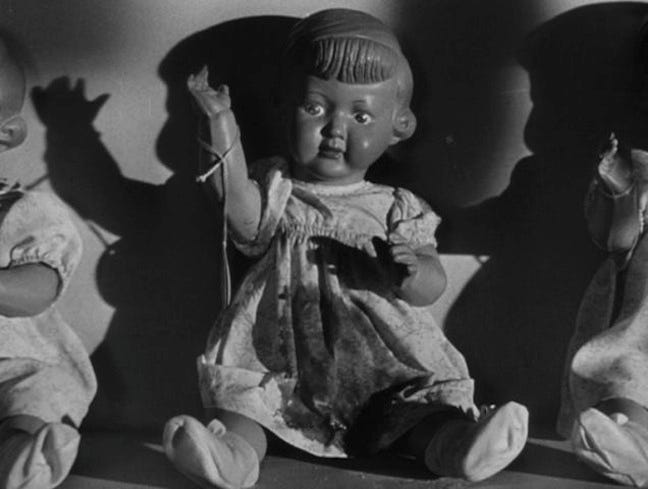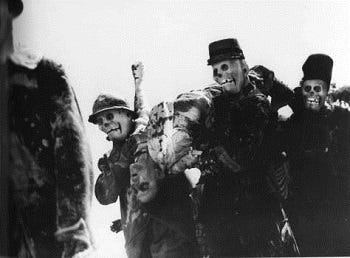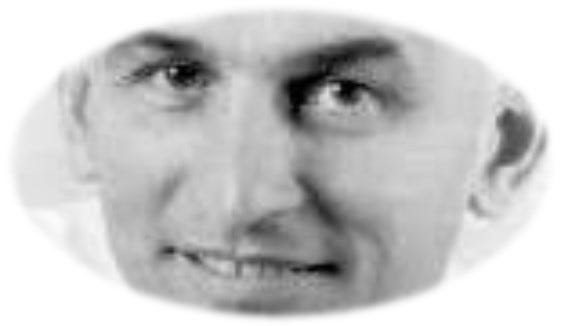The psychiatric term trema, coined by the influential German neurologist Klaus Conrad, is defined by the NIH as “an initial phase in the psychotic process that is characterized by intense anguish, an experience of hostility and a feeling of imminent catastrophe. This situation engenders in the patient a sensation of being in a tunnel than can only lead to something terrible but ineffable.” As befits psychiatric language, the word is a Greek loan meaning hole, gape, perforation.
Though hardly a household name, Dr Klaus Conrad is important to the history of psychiatric literature. His work became the central pillar of the widely-used Bonn Scale for the Assessment of Basic Symptoms, a tool which measures subjective experience in order to identify symptoms that may indicate a risk of psychosis. His landmark book, Die beginnende Schizophrenie. Versuch einer Gestaltanalyse des Wahns, published in 1958, is a significant text in contemporary psychological research. Not just a scholar, Conrad also had field experience as the director of a neurologic military hospital where he amassed a large number of case studies of soldiers experiencing the initial states, the trema, of what he diagnosed as oncoming schizophrenia.
Karl B. was a Private First Class in the German Army during World War II. He told Dr Conrad that he awoke one day to a transformed world. All around, he detected secret plots directed against him, the work of a network of agents who possessed unearthly scientific powers. When a sergeant asks him for the barracks key, he sees in this innocuous request an obscure kind of test. His comrades behave strangely around him, and every ordinary statement from them is conspicuous with ulterior meanings. Anyone leaving a room goes off to ‘receive their instructions’ and when they return, everything they say is a cryptic form of test. When Karl B comes across a group of recruits hanging out with local girls, the girls are actually being briefed on how to fabricate rumors about him (probably of a sexual nature). His orders, which he is by now too disoriented to comprehend, are really more tests, carefully orchestrated to provoke and mystify him. When he leaves camp, the road is strewn with rocks and objects prearranged to form signs and magic symbols. People stare at him, and he is suddenly able to alter their expressions and distort their physical behavior with his thoughts. He claims a ‘wave apparatus’ controls his body and he is being subjected to electric current and bizarre ‘inputs.’ Long-distance influencing machines are relaying information about him to a cabal whose motives are unclear but decidedly sinister.
According to Dr Conrad, the state of trema can last an indeterminate amount of time—hours, days and weeks, even years. A patient will feel ‘something in the air’ but cannot clearly define what it is. His emotions change rapidly. Intoxication is followed by depression; fear follows anticipation and ecstasy. In order to isolate a series of symptoms that seem only to describe the richness and unpredictability of everyday life, Conrad ties them to schizophrenia. His patients recount a landscape wherein every object takes on loaded symbolism and any element of chance has been abolished. Meaning explodes in even the smallest accident; messages of obedience and divine inspiration are atomized in every word the patient hears; nothing is irrelevant. Then there is the fact of the war. The authoritarian structure of the army, the innate paranoia of fascist governance, the apocalypse which engulfed Europe—all of this is openly expressed by the shellshocked basket cases shuffling in to see the doctor. The crippling paranoia of such a world is glaringly evident in the patients’ obsessions with numerology, occult influences, secret societies and spies. Technological weapons control a world where psychological and material space are now identical (V-2 rockets scream across the sky, destroying those minds who escaped the direct target). As the doctor analyzes these men, they unveil for him a magical universe where people are divided into specimens and collaborators under a dark command.
Which was exactly how things were at the time. The fascist propaganda machine created a repressed and repressive culture, full of the ridiculous pomp of orchestrated spectacles and overflowing with violence both emotional and actual. Karl B and others like him were describing in totally realistic terms the state which the National Socialists had brought forth from ideological fantasy into objective reality. Conrad’s definition of Apophenia, another word he coined to describe a stage in the onset of schizophrenia, seems not at all a medical diagnosis but a description of the seductive powers of the Third Reich: "The unmotivated seeing of connections [accompanied by] a specific feeling of abnormal meaningfulness.” Yet Dr Conrad is doomed to consider this apperception as a wholly personal pathology and not the logical product of a political system built on bloody but empty emblems and arcane manipulation.
It is common knowledge that the Nazi Final Solution began as Aktion T4, a program which exterminated some 300,000 mental patients and sterilized even more. This medico-political operation also marked the first attempt to use poison gas as a killing instrument, manufactured by the same company that would later supply the camps, the IG Farben conglomerate. It is also well-known this program was directed under the auspices of the German psychiatric establishment, one of the more liberal centers of mental health at the time. German physicians wrote books and academic papers justifying euthanasia, working to persuade the public that the infirm and insane should not breed and that killing them was actually merciful. Seven of these major figures were sentenced to death for Crimes Against Humanity in the postwar trials (the big industrialist manufacturers of the gas got a slap on the wrist). Though he was never a part of T4, this is the milieu in which Dr Conrad practiced and where he detected, ever blind to that great delusion called the Third Reich, those personality disorders, manias, and dissociative states infecting his patients. Question: What sort of person remains ‘sane’ in such an atmosphere of fascist repression? Wouldn’t such a pathological sanity be a symptom of mental collapse, of the passive refusal to sacrifice one’s own mind when millions of other minds and bodies had already been wantonly destroyed? Did it not occur to Dr Conrad that the National Socialists had themselves produced this so-called schizophrenia, just as it produced race laws, tanks, Luftwaffe and heaven-sent Führers? That the symptoms were created by an ideology whose sanity was only doubted when its shining and ruthless victories vanished before the advancing Red Army in 1945? But Dr Conrad, as most thumbnail sketches of his career candidly admit, had been a card-carrying member of the NSDAP since 1940.
Trema is also called Stage Fright. This brings to mind subjects parading before an invisible crowd, an audience which both dictates and observes the movement of these figures from a vantage point below. You look surprised? But you are always being watched. It is as if surveillance cameras predated the situations they record. But the latter is now a fact, for hyper surveillance does not deter crimes or acts of ‘terrorism’, it only proves that the event occurred—which we already knew. Stage Fright humiliates, freezes, forbids speech and attempts pathetically to control the air. Everything you say has a hundred meanings, carefully concealed in every ordinary suggestion; every jest is a slight and every suggestion is an affront. It is not that language has lost its meaning, but that these meanings are multiplied as transparent accusations, evidence and codes, the delicate proof of some conspiracy which then demands a viciously thin-skinned reaction [i] and the defensive posture of a coward. In this infernal revision of life, all is trauma, and the reductive darkness of the past constantly waits in the wings to eat the present. If you shame someone, it hides the fury of your own petty shame which can only express itself in cruelty and stupidity. Do not leave your house. You have been sinned against. The world which terrifies you owes you everything.
Maybe this is the little fascist living inside of us all. It is not a biological fact but a costume or a uniform, the soiled dress clutched by those who will do almost anything to be safe (Wilhelm Reich called it our Character Armor). It is found in a single man or in a whole regime, which, after all is made up of single men. In the final analysis, this quality is a perverse and incestuous joke. Yet the exterior object of its scorn still has a great power over it—the ability to reduce it to a windy clown and banish it into the night.
[i] The opposite of this devious, cheap sadism is the pun and the malaprop, both of which rely on innocence and laughter. Other kinds of language can be beautiful and even sinister without the need to degradate and control. A person may say something profound by leaving out the subject of a sentence, may create poetry accidentally (and also by a natural ability with words which cannot be learned from books but which springs from the unique expression of her experience and genius). The best of us say what we don’t mean and know it, sometimes and sometimes not. What is important is laughter. Humor wants to provoke convulsions in oneself and in another, so joining oneself with that other. There are two opposing ways of hearing another person’s words. The first is a crude, infantile suspicion that you are being attacked, and the second is to take part in a complex game which makes life worth living and fends off boredom.








Once again, Martin, compliments on your writing.
Envy too weak a noun.
One thing I don't fully understand is the use of the word "vicious" in the sentence preceding (i)....might it instead be 'vicarious?' I couldn't reconcile its meaning, vicious, in the context and grammatical construction in which you used it.
One other point I'd like to posit: for Wilhelm Reich the Character Armor is indeed purely biological,
the rigidification of areas of the body in response to societally imposed strictures, or psychological misconstructions of experiences. It was his major discovery when he realized that for Freud the mental aberrations-- hysterias, neuroses, psychoses-- existed largely cognitively and that for a doctor such as Reich trained initially in anatomy/physiology and the biological processes of lifeforms to not have a somatic basis for such dysfunctions seemed illogical. Thus his discovery of the armoring, akin to building walls within the body for defense which may originally have served protective function, but after the threat no longer at the same level, became monkey wrenches in the mental machinery.
Obviously the body and mind intimately homogenous, holographic.
Thus his therapeutic approach altered profoundly from Freud's 'talking cure' in which cathexed repressions came into awareness for control or elimination to one of releasing the chronic somatic tightnesses with or without those embodied trauma responses needing to reach consciousness. Consequently, once Freud's favorite, Reich split ranks with Freud's psychiatric approach to endorse somatic release therapy, as you undoubtedly know.
The influencing machine has been of interest to me for some time. When I first read a description of it I immediately thought that it sounds like the screen, social media, the internet. Not to mention the spiritual dimensions of influence. The state of things now is sending more and more people into psychosis because they are actually breaking bodies, minds, hearts. It's too much to bear. It takes a lot of energy to keep up all the lies we've created civilization around. The split is driven so far it shards into pieces.
I do think the perception of the nature of reality and maybe even reality itself is becoming loser and more unhinged, for better and for worse. It is kind of a nice switch up compared to what I perceive as the rigidity of the past but the transition right now is pretty harrowing with those trying to hold on so hard to homogony and control. They will fall.
Thank you for this synchronically charged reflection, Martin. I absolutely love your writing and perspective. It's a gift.